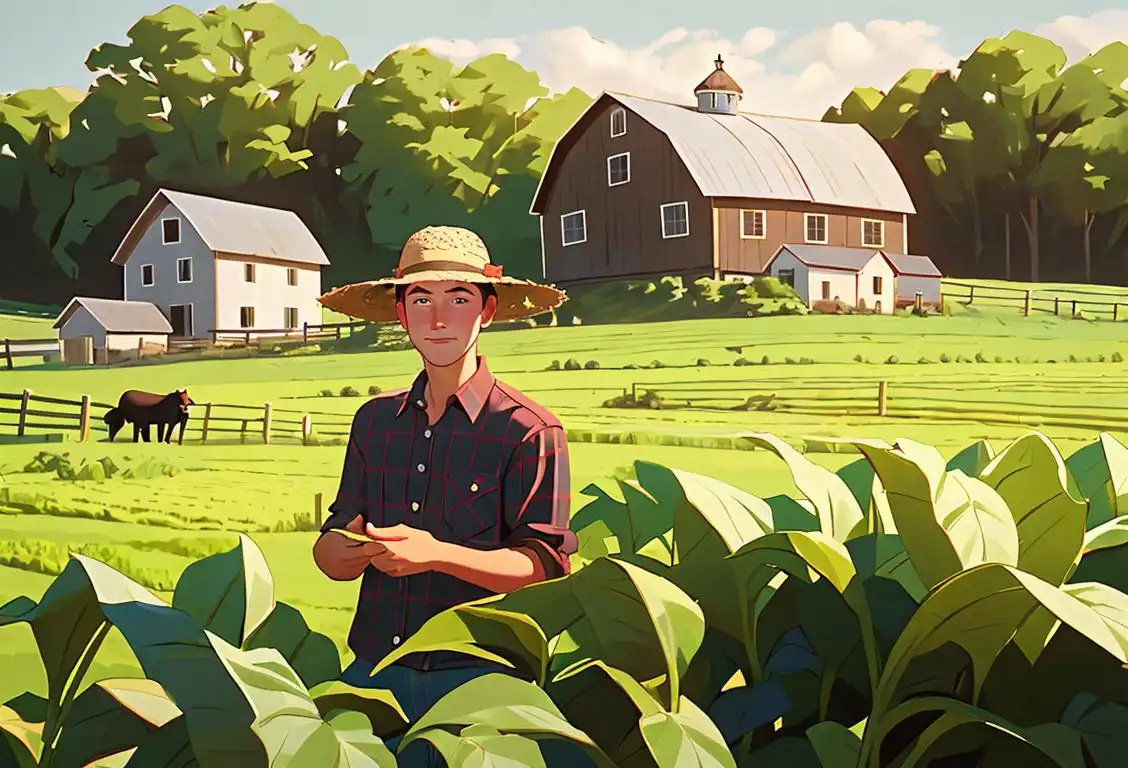National Canning Day

Hey there canning enthusiasts! Get your mason jars and aprons ready because National Canning Day is here to fill your life with jars of joy and flavors that'll make your taste buds dance.
When is Canning Day?
It's national canning day on the 23rd October.
The Sweet and Savory World of Canning
If you've ever wondered how to preserve your favorite fruits, vegetables, and even meats, canning is the answer! It's a timeless practice that allows us to enjoy the taste of summer all year round. The origins of canning can be traced back to the early 19th century when a French chef, Nicolas Appert, discovered that by sealing food in glass jars and heating them, they stayed preserved for longer periods.
Since then, canning has become a popular way to prolong the shelf life of a wide variety of foods. From pickles to jams, and from tomatoes to salsas - there's no limit to what you can preserve in a can! Plus, it's a fantastic way to make use of that bountiful harvest from your garden or support local farmers by stocking up on seasonal produce.
Not only does canning add convenience to our lives, but it also adds a touch of nostalgia. There's something incredibly satisfying about seeing those neatly lined jars stacked in your pantry, ready to be enjoyed when you're craving that homemade goodness.
Canning: A Community Bonding Experience
One of the best parts of canning is that it's often a group activity. Gathering with loved ones, passing down family canning recipes, and sharing stories while preparing and preserving food - it's a bonding experience like no other. You'll create memories that will last a lifetime (or at least until you run out of those delicious canned goodies).
Imagine spending a cozy autumn afternoon with your favorite people, peeling apples, and making apple pie filling to be sealed into jars. Or maybe you're spending a sunny summer day with friends, chopping up fresh vegetables from your garden to create a tangy salsa that you can enjoy on a cold winter night. The possibilities are endless, and the joy of canning is contagious!
A Fun Fact to Impress Your Fellow Canners
Did you know that the largest can of soup ever created was opened in 1985? Weighing a whopping 1,588 pounds, this massive can held Cream of Mushroom soup and made its way into the Guinness World Records. That's a lot of soup to ladle out!
History behind the term 'Canning'
1795
Napoleon's Call
In the year 1795, during the time of Napoleon Bonaparte, the French government offered a cash prize to anyone who could discover a method to preserve food so that it could be stored for long periods of time without spoiling. This call was made in an effort to address the issue of providing sustenance to the French army during their campaigns.
1809
The Beginnings of Preserving Food
In 1809, a French chef named Nicolas Appert discovered a method of preserving food by sealing it in jars. He experimented with various foodstuffs and found that by heating the food and sealing it in airtight containers, he could preserve it for long periods of time without spoilage. This marked the beginning of the canning process, although the term 'canning' had not yet been coined.
1809
The Birth of Canning
In 1809, the term 'canning' was coined in honor of the British businessman and inventor, Nicholas Appert. Appert developed a method of preserving food in sealed glass jars, which later became known as canning. His invention revolutionized the food industry by providing a reliable way to preserve perishable items and ensure their long-term storage.
1795
The birth of canning
Canning, the process of preserving food in sealed containers, was invented by Frenchman Nicolas Appert in 1795. Appert discovered that by sealing food in glass jars and heating them, the food could be preserved for long periods without spoiling. His preservation method revolutionized the food industry and became the foundation for modern-day canning.
1795
Napoleon's Food Preservation Prize
In 1795, Napoleon Bonaparte, the French military and political leader, offered a prize to whoever could find a reliable method of preserving large amounts of food for his armies. This sparked the pursuit of a solution to this challenge.
1795
The birth of canning
In 1795, the process of canning was introduced by a French chef named Nicolas Appert. He discovered that food could be preserved by sealing it in a container and heating it to destroy any bacteria or microorganisms. Appert's method involved sealing food in glass jars with cork and wax.
1809
Napoleon Bonaparte initiates the canning process
In the year 1809, Napoleon Bonaparte offered a cash prize to anyone who could safely preserve food for his army. A French confectioner named Nicolas Appert rose to the challenge and developed the process of sealing food in glass jars with cork and wax. This marked the birth of canning as a preservation method.
1809
Napoleon's Food Preservation Challenge
In the early 19th century, the French emperor Napoleon Bonaparte offered a prize to anyone who could find a way to preserve food for his troops during their long military campaigns. This sparked the interest of Nicolas Appert, a confectioner and chef, who began experimenting with various preservation methods.
1806
The science behind canning
In 1806, Englishman Peter Durand received a patent for a method of canning using tin-plated cans. This innovation made canning more practical and allowed for mass production. Durand's idea was based on the principle that airtight containers and proper heating would prevent spoilage and extend the shelf life of various food items.
1810
Peter Durand introduces tin cans
In 1810, an English merchant named Peter Durand acquired the patent rights for Nicholas Appert's process and made a significant modification. Durand replaced the fragile glass jars with sturdy tin-plated steel cans. This breakthrough brought about a major advancement in canning by ensuring greater durability and a longer shelf life for preserved food.
1809
Napoleon Bonaparte's influence
In 1809, Napoleon Bonaparte recognized the importance of Appert's invention and offered a prize of 12,000 francs to anyone who could discover a reliable food preservation method. This stimulated further interest in canning and encouraged others to improve upon Appert's initial process.
1810
Appert's Discovery: Canning
In 1810, Nicolas Appert finally achieved success in his experiments. He discovered that by sealing food in airtight jars, and then heating them in boiling water, the food would remain safe to eat for extended periods of time. This revolutionary technique, known as canning, changed the way people preserved food and had a significant impact on food security, military logistics, and exploration.
1810
Appert's Discovery Spreads
After Nicholas Appert's breakthrough invention, it quickly gained recognition and started to spread beyond Britain. In 1810, another innovator, Peter Durand, received a patent in England for a metal canister to further enhance the canning process. This development allowed for the use of tin cans, which were more durable and cheaper than glass jars.
1809
France Introduces Glass Jars
In 1809, Nicolas Appert, a French chef and confectioner, discovered a method for preserving food by sealing it in glass jars. He developed this technique in response to Napoleon's prize, and it was the birth of canning as we know it today.
1809
Appert's Invention
In 1809, a French confectioner and inventor named Nicolas Appert successfully developed a method of preserving food in jars. He achieved this by sealing the food in glass jars, which were then heated and hermetically sealed with a cork and wax. This process allowed the food to be kept preserved for extended periods without spoiling.
1810
The British Take Notice
In 1810, the British Navy started to take an interest in Appert's preservation method. They recognized the potential of canned food for their sailors on long voyages, as it would provide them with a reliable source of sustenance. The British government offered a cash prize of £20,000 to anyone who could develop a practical method for preserving food in cans.
1810
Recognition of Appert's Method
In 1810, Nicolas Appert's method of preserving food in jars was recognized and awarded by the French government. This recognition led to the establishment of the canning industry, as other inventors and entrepreneurs began to adopt and refine Appert's technique for preserving various types of food.
1812
Bryan Donkin establishes the first commercial canning factory
In the year 1812, Bryan Donkin, an English engineer, set up the world's first commercial canning factory in London. The factory utilized Durand's tin cans and Appert's canning process to produce a wide variety of preserved foods. Donkin's factory marked a significant milestone in the mass production and widespread availability of canned goods.
1812
Peter Durand Patents Tin Cans
In 1812, a British merchant named Peter Durand obtained a patent for a method of preserving food by sealing it in tin-plated iron cans. This innovation marked a significant advancement in canning technology, as tin cans were more durable and less prone to breakage than glass jars. Durand's patent paved the way for the widespread adoption of tin cans for food preservation.
1810
The iconic can opener
In 1810, the first patented can opener, known as the 'steel knife,' was invented by Englishman William Lyman. This breakthrough made it much easier for people to access the contents of canned food, leading to increased popularity and widespread adoption of canned goods.
1810
Canning Patent
In 1810, Peter Durand, a British merchant, received the first patent for a process of preserving food using tin-coated steel cans. This innovation allowed for more durable and efficient food storage and distribution.
1810
The Term 'Canning' is Coined
Around the same time, the term 'canning' emerged as a way to describe the process of preserving food in sealed containers. The name 'canning' is derived from the use of canisters or cans to store the preserved food. The term quickly gained popularity and became widely used to describe the overall preservation method.
1812
Canned Food Reaches the Military
In 1812, during the Napoleonic Wars, the French government recognized the potential of canned food for their military. They started using canned provisions to feed their troops, providing a solution to the logistical challenges of supplying fresh food to soldiers in distant locations. This military application played a crucial role in popularizing canned food globally.
1810
Peter Durand's tin can invention
In 1810, Englishman Peter Durand further developed the canning process by replacing glass jars with tin-coated iron containers. Durand's invention of the tin can made canning more accessible and durable, paving the way for the mass production of canned food.
1812
First commercial canning factory
In 1812, the first commercial canning factory was established by Bryan Donkin and John Hall in London. The factory utilized Peter Durand's tin cans and produced preserved food on a large scale. This marked the beginning of the industrialization of canning and led to its widespread adoption.
1812
Army Rations
During the War of 1812, canned foods became a staple in the diets of soldiers. The American army relied on canned goods as a convenient and long-lasting source of sustenance, further popularizing the practice of canning.
1858
Mason Jars: A New Canning Option
In 1858, John Landis Mason, an American tinsmith, invented and patented a new type of glass jar, now famously known as the Mason jar. These jars featured a screw-on metal lid with a rubber seal, which provided an airtight closure. Mason jars quickly became a popular choice for home canning, allowing people to preserve their own fruits, vegetables, and homemade jams.
1858
The Mason Jar Revolution
In 1858, John Landis Mason invented the iconic Mason jar, which became a fundamental tool in the canning process. The glass jar featured a threaded neck and a zinc-coated metal lid with a rubber seal. The Mason jar made canning more accessible to households, allowing individuals to preserve their own foods easily. It became a staple for home canning enthusiasts worldwide.
1813
Peter Durand's Tin-Coated Cans
In 1813, British merchant Peter Durand patented a method for preserving food in tin-coated iron cans. This innovation improved the durability and longevity of the containers, making them more suitable for long-distance travel and storage. Durand's patent marked a significant advancement in the canning process.
1858
John Mason invents the screw-on lid
John L. Mason, an American tinsmith, invented the iconic screw-on lid in the year 1858. His development provided a more secure and reusable sealing method for canning jars. The Mason jar, as it came to be known, became incredibly popular and is still widely used today for home canning and preserving.
1819
The canning process improved
In 1819, Frenchman Philippe de Girard invented a method of sealing cans using a double seam. This technique revolutionized the canning process, providing a more secure and reliable seal. Girard's innovation allowed canned food to be transported over longer distances and stored for extended periods without spoilage.
1810s
Expansion of Canning
Throughout the 1810s, canning quickly gained popularity and spread beyond France. The British navy, in particular, embraced canning as a means of storing food for their long sea voyages, improving their ability to sustain themselves during extended periods at sea. The expansion of canning also led to advancements in the packaging materials used, with tinned iron cans replacing glass jars for greater durability and convenience.
1839
Canned food reaches the United States
In 1839, Thomas Kensett, an American chemist, introduced canned food to the United States. Kensett's canned oysters were well-received and sparked the popularity of canned goods in America. Canning quickly became a convenient and efficient way to preserve food, especially for long journeys and military use.
1858
The Mason jar revolution
In 1858, American inventor John L. Mason patented the Mason jar, a glass jar with a threaded neck and a two-part lid. This invention revolutionized home canning, providing an accessible and effective method for individuals to preserve and store their own food. The Mason jar quickly became a staple in canning households and is still widely used today.
1895
Development of the first home pressure canner
In 1895, the first home pressure canner, named the 'Perfect Canner,' was introduced by the National Canner's Association. This innovation allowed people to safely and effectively can low-acid foods, such as vegetables and meats, at home. The invention of the home pressure canner revolutionized canning practices for individuals and contributed to the growth of home canning as a widespread practice.
1818
The First Canning Factory
In 1818, the first commercial canning factory was established in England. This factory, owned by Bryan Donkin and John Hall, produced canned meat using Durand's tin-coated cans. The factory's success sparked the rapid growth of the canned food industry, leading to the widespread availability of canned goods.
1900s
Industrialization of Canning
In the early 1900s, canning transitioned from predominantly a home-based practice to an industrialized process. Advances in technology enabled large-scale canning operations, making commercially canned products widely available to consumers. The increased convenience and improved shelf life of canned food contributed significantly to their popularity.
1858
Mason Jar Invention
In 1858, John L. Mason, an inventor from the United States, patented the design for a reusable glass jar with a threaded screw-on lid. This invention revolutionized the canning process, as it provided a more convenient method of sealing jars compared to the previous cumbersome sealing techniques. The Mason jar became widely popular and remains an iconic symbol of home canning to this day.
1920s
Commercialization and Industrialization of Canning
By the 1920s, the canning industry had experienced significant development and growth. Commercial canneries emerged, equipped with specialized machinery and techniques to efficiently process and preserve a variety of food products on a large scale. Canned foods became widespread in households and played a crucial role in ensuring food availability and convenience for consumers.
1858
Mason Jar Invention
In 1858, John L. Mason invented and patented the Mason jar, a glass jar with a screw-on metal lid. This innovation made home canning more accessible and allowed people to preserve food without relying on specialized equipment.
1858
The Mason Jar Revolution
In 1858, John Landis Mason invented the Mason jar, a reusable glass jar with a threaded neck that could be tightly sealed with a metal lid. This jar revolutionized home canning, as it provided a more convenient and affordable alternative to expensive tin cans. The Mason jar quickly became a household staple and is still widely used for home canning today.
Today
Canning's Modern Resurgence
While canning faced some decline with the rise of refrigeration and frozen foods, it has experienced a resurgence in recent years. The modern canning movement promotes homemade, preservative-free foods and emphasizes sustainability. Canning enthusiasts explore unique recipes, experiment with flavors, and enjoy the satisfaction of preserving their own food. Canning remains a delightful way to enhance food preservation while embracing tradition and craftsmanship.
1914
Louis Appert's induction sealing process
Louis Appert, the grandson of Nicolas Appert, revolutionized canning once again in 1914. He developed the induction sealing process, which allowed for the hermetic sealing of cans using electric currents. This breakthrough technique ensured a more airtight seal, enhancing the preservation and longevity of canned foods. The induction sealing process became an industry standard and further refined the canning industry.
1861
Canning factories emerge
In 1861, the first commercial canning factory was established in England. Canning factories rapidly spread across Europe and North America, taking advantage of the growing demand for canned food. These factories utilized more advanced machinery and techniques to streamline the canning process and produce canned products on a large scale.
1866
Wide-Scale Industrial Canning
With the growth of technology and industrialization, canning techniques became more refined. By the late 1800s, large-scale canning factories had emerged, allowing for the mass production of preserved foods.
1858
John Mason's patent for the Mason jar
In 1858, John Landis Mason patented the iconic Mason jar, a glass jar with a threaded metal lid. This invention revolutionized home canning, allowing individuals to preserve food in their own kitchens using reusable containers. The Mason jar remains a popular choice for canning enthusiasts to this day.
1900s
Canned food during world wars
During both World War I and World War II, canned food played a pivotal role in providing sustenance to soldiers on the front lines and civilians at home. Canned rations became a reliable and efficient way to supply troops with nutritious meals, while also preserving food during times of scarcity. The prominence of canned food during these wars further solidified its place in modern diets.
1920s
Canned Convenience
During the 1920s, canned foods experienced a surge in popularity due to their convenience and extended shelf life. Manufacturers introduced a wide variety of canned products, from fruits and vegetables to soups and meats.
late 19th century
Advancements in canning technology
Throughout the late 19th century, advancements in canning technology greatly improved the quality and safety of canned goods. The development of better sealing methods, including vacuum sealing, reduced the risk of spoilage. Additionally, improvements in commercial canning machinery increased efficiency and allowed for faster production.
1900s
Advancements in Canning Technology
Throughout the 1900s, advancements in canning technology continued to improve the efficiency and safety of the process. The introduction of automated canning machines, improvements in sterilization techniques, and the development of new packaging materials further streamlined the canning industry. Canned food became even more popular and convenient, providing people with a variety of preserved options.
1970s
Development of the retort pouch
In the 1970s, the US Army, in collaboration with private companies, developed the retort pouch as a lightweight and flexible alternative to traditional cans. The retort pouch is a heat-resistant plastic pouch that can withstand high temperatures during the canning process. This packaging innovation resulted in improved portability, reduced weight, and increased convenience for canned food consumers.
1970s
Home Canning Renaissance
In the 1970s, there was a resurgence of interest in home canning as people sought to embrace self-sufficiency and preserve locally sourced produce. This trend continued, and today many individuals enjoy the process of canning at home as a way to enjoy seasonal flavors year-round.
20th century
Diversification and innovation
Throughout the 20th century, canning techniques continued to evolve, allowing for a wider range of foods to be preserved and stored. Innovations such as vacuum sealing and the use of different materials for cans and lids improved food safety and extended shelf life. Canning became an important aspect of the food industry, enabling the mass production and distribution of various products.
early 20th century
Canned food during wartime
During the early 20th century, canned food played a crucial role in wartime. Canned rations provided sustenance for soldiers on the front lines and helped ensure a stable food supply. The durability and long shelf life of canned goods made them ideal for military use and contributed to their continued popularity.
mid-20th century
Canned food in daily life
In the mid-20th century, canned food became a staple in many households. With advancements in canning technology, a wide variety of fruits, vegetables, meats, and soups were available in cans. Canned food offered convenience, extended shelf life, and nutritional value, making it a convenient option for busy families.
21st century
Canning as a popular hobby
In the 21st century, canning has experienced a resurgence in popularity as a hobby and a way to preserve seasonal produce. Many people enjoy the process of canning their own jams, pickles, and sauces, embracing the art of homemade preservation. Canning has also gained attention for its role in sustainable living and reducing food waste.
present day
Continued importance of canning
Canning remains an important method of food preservation and distribution worldwide. It allows for the availability of diverse food options year-round and helps reduce dependence on fresh produce during off-seasons. Canned food continues to serve as a reliable and convenient source of nutrition, ensuring food security for people around the globe.
Did you know?
The largest can of soup ever created weighed 1,588 pounds!Tagged
food fun loved onesFirst identified
23rd October 2015Most mentioned on
23rd October 2015Total mentions
54Other days
Biscuit Day
Cheese Lovers Day
Cheese Pizza Day
Agriculture Day
Bacon Day
Medal Of Honor Day
Pumpkin Day
Foundation Day
Guac Day
Drink A Beer Day









